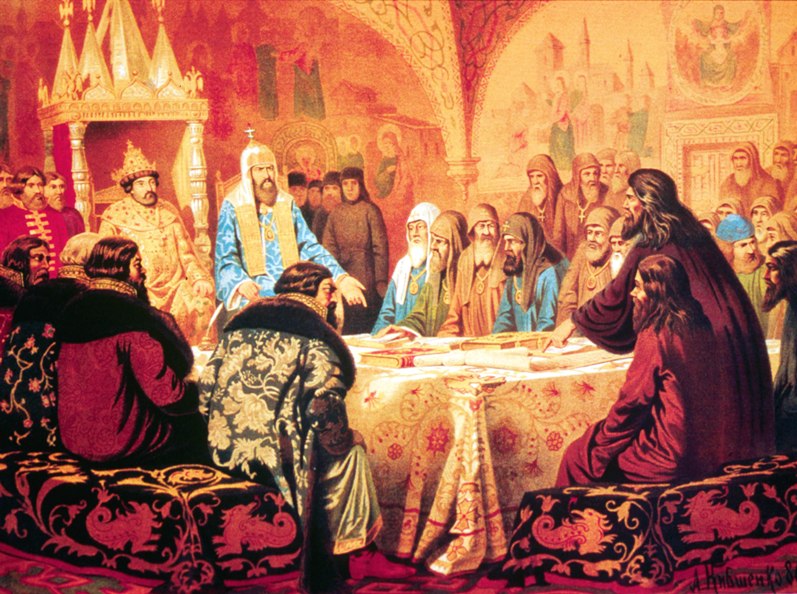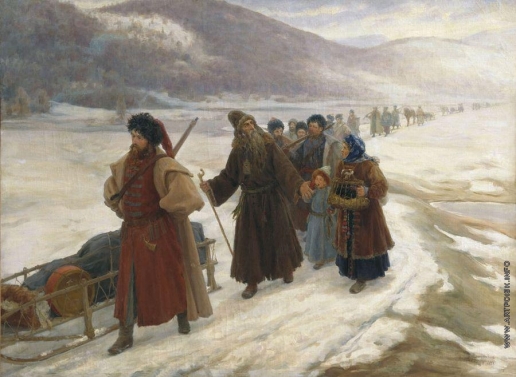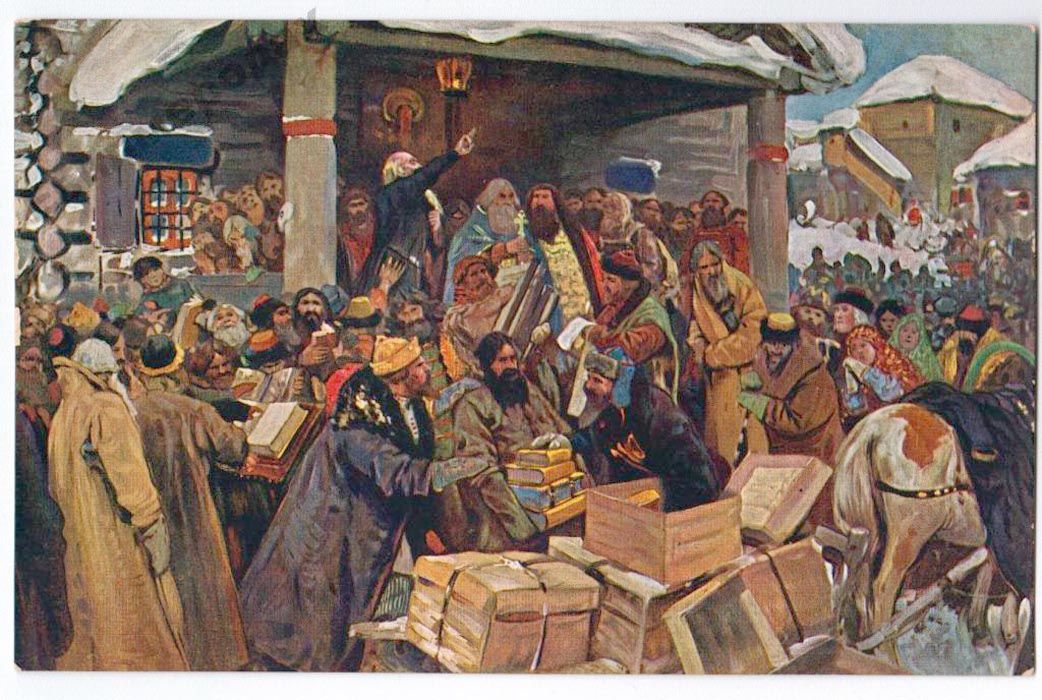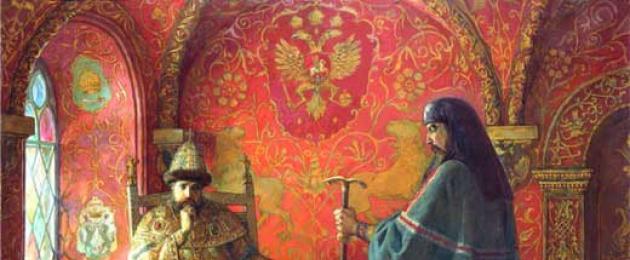In the 21st century, there is not a single social institution left in Russia that has not been affected by certain transformations, with the exception of the most conservative of them - the Russian Orthodox Church. Disputes and discussions about reforming church life have been going on for a long time. Questions about the replacement of texts from Church Slavonic into Russian, the transition to the New Julian calendar, the adoption of a charter for the laity are widely discussed in secular and Orthodox media.
However, it is necessary to recall, at least briefly, the church schism of the 17th century, when the Orthodox Church was reformed, the result of which was the split of the Russian people, and its consequences have not been overcome to this day.
Reasons for church reform in the 17th century
Discussion of the need to reform church life began in the 1640s. At that time, a “circle of zealots of piety” was organized in the capital. Representatives of the clergy, who were members of the circle, advocated the unification of church texts and the rules of worship. However, there was no unity on the issue of choosing a model according to which changes would be made. Some suggested taking ancient Russian church books as a model, while others suggested Greek ones.
As a result, those who advocated bringing church books and rituals in line with Byzantine canons won, and there were several explanations for this:
- The desire of the Russian state to strengthen its international position among the Orthodox countries. In government circles, the theory of Moscow as the Third Rome, put forward as early as the 15th century by the Pskov elder Philotheus, was popular. After the church schism in 1054, Constantinople became the spiritual center of the Orthodox Church. Philotheus believed that after the fall of Byzantium, the Russian capital became a stronghold of the true Orthodox faith. To confirm this status of Moscow, the Russian Tsar had to enlist the support of the Greek Church. To do this, it was necessary to bring the worship service in line with Greek rules.
- In 1654, the territory of Polish Ukraine, by decision of the Pereyaslav Rada, joined the Russian state. In the new lands, the Orthodox liturgy was held according to the Greek canons, so the unification of liturgical rules would contribute to the process of unification of Russia and Little Russia.
- Stabilization of the internal political situation. A little time has passed since the events of the Time of Troubles died down, and small pockets of popular unrest still periodically flared up in the country. The establishment of uniformity in the rules of church life seemed to the government an important tool in maintaining national unity.
- Inconsistency of Russian worship with Byzantine canons. Amendments to the liturgical rules, which caused the church schism, were secondary to the implementation of church reform.
Tsar Alexei Mikhailovich and Patriarch Nikon
So under what tsar did the church split of the Russian people occur? Under the sovereign Alexei Mikhailovich, who reigned from 1645 to 1676. He was an active ruler, diligently delving into all issues relating to Russia. Considering himself a true Orthodox, he paid a lot of attention to church affairs.
In Russia, the church schism is associated with the name of Patriarch Nikon, known in the world as Nikita Minin (1605-1681). By the will of his parents, he became a clergyman and in this field he managed to make a brilliant career. In 1643 he received the high spiritual rank of abbot of the Kozheozersky monastery in the Arkhangelsk province.
In 1646, Nikon, having arrived in Moscow to settle monastic affairs, was introduced to the young Tsar Alexei Mikhailovich. The seventeen-year-old sovereign liked the abbot so much that he left him at court, appointing him archimandrite of the Moscow Novospassky Monastery. Thanks to royal mercy, Nikon later received the rank of Metropolitan of Novgorod.

Tsar Alexei Mikhailovich and Patriarch Nikon - the initiators of church reform in the 17th century
By order of the tsar, in 1651, Nikon was again returned to Moscow, and from that moment on, his influence on Alexei Mikhailovich increased even more. He entered into full confidence in the sovereign, actively participated in solving many state issues. Nikon reached the pinnacle of his career in 1652, having ascended the patriarchal throne, after the death of Patriarch Joseph. From that time, preparations began for church reform, the need for which had been brewing for a long time.
Briefly about the reforms of Patriarch Nikon and the church schism
The first thing the new patriarch focused on was the editing of all church books, which needed to be brought into line with the Greek canons. However, the starting date for the church schism of the 17th century is considered to be 1653, when changes are introduced to the liturgical rules, and a confrontation begins between Patriarch Nikon and his supporters, on the one hand, and adherents of the old rites, on the other.

Now let us dwell briefly on Nikon's reforms and the church schism that followed them:
- replacement of a two-fingered sign with a three-fingered one. Opponents of the reforms, this innovation caused the most criticism. The sign of the cross, performed in a new way, was regarded as disrespect for the Lord himself, because from three fingers a “fig to God” was obtained;
- spelling "Jesus" instead of "Jesus";
- reducing the number of prosphora for the liturgy;
- during the service, instead of bowing to the ground, it was necessary to make waist ones;
- the movement during the procession was now made against the sun;
- in church singing they began to say “Hallelujah” three times instead of two.
The reforms carried out by Patriarch Nikon became the main and main cause of the church schism in the 17th century.
What is a church schism and what are its causes?
The Russian church schism is the separation of a significant part of the believing population from the Orthodox Church and those who oppose church reforms carried out by Patriarch Nikon.
Speaking briefly about the causes of the church schism of the 17th century, which had an impact on the entire subsequent history of the Russian state, they were directly related to the short-sighted policy of the secular and church authorities.
It should be noted that the church schism had a negative impact on relations between the authorities and the church, which can be briefly described as cooling and confrontation. The reason for this was the harsh methods that guided Patriarch Nikon, carrying out his reform. By order of the king in 1660, the spiritual council deposed Nikon from the patriarchal throne. Later he was deprived of his priesthood and exiled to the Feropontov Belozersky Monastery.
With the removal of Nikon from power, church reforms were not curtailed. In 1666, the Church Council officially approved the new rites and church books, which were to be accepted by the entire Orthodox Church. By the decision of the same Council, adherents of the "old faith" were excommunicated and equated with heretics.
Now let's take a closer look at the causes and consequences of the church schism:
- the methods by which church reforms were carried out alienated a significant part of the clergy and the common people, namely the forcible seizure of church books, icons and other shrines that did not correspond to the Greek canons and their further public destruction;
- the abrupt and ill-conceived transition to the new rules of worship caused the masses to believe that they were trying to impose a different faith. In addition, those who refused to accept the innovations were subjected to serious corporal punishment, which did not add sympathy to Patriarch Nikon and his entourage;
- the low level of education, and sometimes the complete illiteracy of the parish clergy, unable to explain to the parishioners the essence of the change in the liturgy;
- unscrupulous translation of individual texts from Greek into Russian, which, although slightly, began to differ from the former Old Russian ones. The greatest indignation among believers was caused by changes in the meaning of the prayer, the Symbol of Faith, where in the new edition the Kingdom of God is spoken of in the future tense, and not in the present, as it was before;
- lack of unity and agreement in the church environment on the issue of ongoing reforms. As a result, opponents of innovations appeared among the clergy, who became the spiritual leaders of the Old Believers.
The church schism in Russia is associated with the name of Archpriest Avvakum Petrov, a well-known leader of the Old Believers. For disagreement with church reforms, he was exiled for a long eleven years to Siberia. Having endured many hardships and hardships, he remained devoted to the "old faith". As a result, by decision of the Church Council, Avvakum was sentenced to imprisonment in an earthen prison, and later burned alive.

Miloradovich S.D.
Avvakum's Journey through Siberia. 1898.
The causes and consequences of the church schism can be briefly described as the rejection of Nikon's reforms by a significant part of the believers, which then resulted in a religious war. The Old Believers were persecuted and persecuted by the government and were forced to seek salvation on the outskirts of the Russian state. The response of the Old Believers to church policy was mass self-immolation, called "gary".
In the historical literature, one often encounters the definition of a church schism as the starting point for mass popular unrest that periodically shook the Russian land during the 17th and 18th centuries. Indeed, the Old Believers found strong support among the common people, it was around them that all those dissatisfied with the existing order in the country began to gather.
The Significance of the Church Schism
- The church schism in Russia in the 17th century became a national tragedy. There was a division of the Russian people into those who remained in the bosom of the Orthodox Church, performing divine services according to the new rules, and into the Old Believers, who continued to adhere to the pre-reform church rites.
- As a result of the church schism, the spiritual unity of the Russian people ceased to exist. For the first time in the history of the state, enmity arises on religious grounds. In addition, social disunity among the population began to manifest itself more clearly.
- The supremacy of royal power over the church is established. The church reform was initiated by the government and carried out with its support. And this was the beginning to the fact that the management of church affairs began to gradually move into the state department. This process was finally completed under Peter the Great, who abolished the institution of the patriarchate.
- There is a strengthening of the international position of Russia and its ties with the countries of the Orthodox world.
- Speaking briefly about the positive significance of the church schism, the emerging Old Believer movement made a significant contribution to the development of Russian art. They created a number of spiritual centers, their own icon-painting school, preserved the ancient Russian traditions of book writing and Znamenny singing.

The concept of a church schism arose during the reign of Alexei Mikhailovich and since then has repeatedly become a topic for historical research. Most historians argue that the true cause of the church schism in the 17th century was not at all in the dispute over amendments to worship. The whole point is one significant question - whether the secular and ecclesiastical authorities can decide how and in what way the people believe in Christ, or whether the people have the right to keep intact the rituals and way of church life, established many centuries ago.
- In contact with 0
- Google+ 0
- OK 0
- Facebook 0








